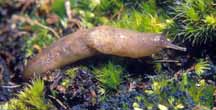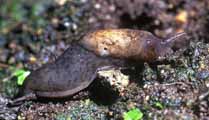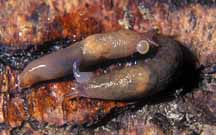Land Snails
Deroceras invadens (Reise, Hutchinson, Schunack & Schlitt, 2011) (non-native) (not yet recorded)



Photo(s): Deroceras invadens can be a range of color values. Note the lighter patch on the mantle. The third image shows two animals preparing to mate, with penises partially everted at the right side of the head. Images © Roy Anderson.
Family: Agriolimacidae
Common name: none
Identification
Length: 20-35 mm
Deroceras invadens adults are usually 20–35 mm long and vary from light greyish-brown to almost black. (Reise et al. 2011). The skin and flesh are fairly transparent, with a watery, colorless mucus (Reise et al. 2006). The respiratory pore is often, but not always, pale.
Deroceras invadens can closely resemble some native Deroceras laeve, but they can usually be separated by the shape of the tail when the slug is disturbed (Reise et al. 2006). In profile, the end of the tail of D. invadens usually slants vertically upward or even backward for a short distance from the sole, while the tail of Deroceras laeve slopes forward above the sole.
Internally, D. invadens has a penis that is divided into two massive lobes, with 4-6 fingerlike projections in the valley between the lobes (Reise et al. 2011; Forsyth 2014), while D. laeve has a different penis lacking fingerlike projections.
Ecology
This species typically occurs in disturbed areas. It prefers habitats with high humidity and cannot survive at temperatures below –7°C. It can be a major pest in gardens, greenhouses, and pasture (Barker 2002).
Taxonomy
Deroceras invadens is a global “tramp” species native to Europe. In North America, until recently this animal had been incorrectly called D. panormitanum or D. caruanae.
Distribution
Not yet reported from Virginia, D. invadens has been documented outside of greenhouses in adjacent Washington DC, as well as in Newfoundland, and inside of greenhouses in Quebec (Reise et al. 2006; Forsyth 2014). It is probably much more widely distributed than these reports suggest.
Conservation
NatureServe Global Rank: G5, Secure.
Tim Pearce 02/2014


